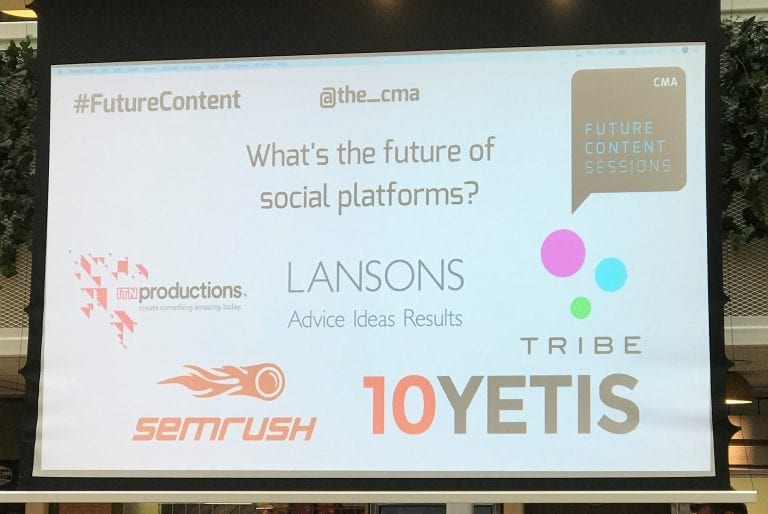|
Getting your Trinity Audio player ready...
|
The Content Marketing Association (CMA) held their third future content series event earlier this week. Simply titled, ‘What’s the future of social platforms?’, talented practitioners from across the industry provided very different perspectives on where content marketing is heading.
Against a backdrop of Snapchat’s mixed results, the ongoing trust issues of Facebook and its users, and YouTube’s struggle to balance the needs of advertisers and its valuable community; talking about the future of social media is no easy feat. Earlier this week Lydia Wise (Lansons), Andy Barr (10 Yetis), Joanna Boyd (ITN Productions), Lisa Targett (Tribe), and Craig Campbell (SEMrush) took to the CMA stage.

All coming from very different backgrounds, it shows how the CMA leans on its network of creatives and industry leaders to tackle emerging developments. This is often neatly achieved by witnessing how content is affecting brands and social media today.
The conversation revealed:
#1 Content fatigue is everywhere
All social media algorithms are similar, content must be published quickly and be original. Influencers are under stress to produce content daily, leading to what The Guardian has described as “YouTubers are feeling the burn”. The pace of building yourself an engaged community online is hard work, consuming every waking hour.
It’s not just YouTubers, Instagrammers, tweeters who are feeling the pressure, even news organisations are. YouTube is an important revenue stream for ITN Productions and they’re finding news content requires more shock factor. Even fluffy animal stories aren’t cutting it anymore. Of course, anything to do with Love Island performs just fine.
#2 Brands will create less content
In an age of content fatigue, brands should rely on influencers to help them create quality content. Partnerships with micro influencers can bring originality and new perspectives on how companies can use content to engage with their audiences. Currently most brands are playing a high-volume content marketing game, often leading to a lack of quality and inevitable disillusionment with target audiences.
#3 Mobile first influences creation and consumption
Nobody takes landscape photos anymore, Instagram has put vertical image formats first. Our content is heavily influenced by the device we turn to first, smartphones. With more vertical content being created, even TV manufacturers are beginning to introduce swiveling sets to fit the formats. Also, watch this space as “NewTV” may bring Hollywood blockbuster content designed specifically for smartphones.
#4 Virtual Reality and 360 videos aren’t scalable
The ongoing hype and promise of virtual reality and 360 video content is deafening. However, it currently has some real sticking points; it’s not very social, the technology still needs perfecting, and it’s typically more expensive to produce. The other possibility is that content could easily be locked by the technology companies that develop the platforms. For concerts and gaming, the technology is spot on. Otherwise, the mentioned barriers need tackling.
#5 Old social must reinvent and protect
Social media is a battleground of new content formats and communities. For instance, the Snapchat Story format came to Instagram, then Facebook adapted for their site; quick-fire visual content that disappears feels like its driving more engagement than
#FutureContent – #LinkedIn is that weird uncle that you keep talking to because one day he’ll give you money. ‘@10Yetis’
— Rob John (@RobJohn0) August 14, 2018
#6 Social data fuels aspirations
Social influencers are generally good at understanding the targeted aspirations of their audience and creating content to realise it. Companies must do the same. From a consumer perspective, Nike is doing this with their ‘Melrose’ experience:
On top of providing a selection of Nike.com bestsellers and essential Running, Training and Sportswear product, Nike by Melrose will offer city-specific styles — all of which is determined by Nike digital commerce data (things like buying patterns, app usage and engagement) to serve local NikePlus members exactly what they want when they want it.”
#7 Automation is an opportunity and risk
A few tools exist that allow people to automate aspects of their social profiles, simulating meaningful engagements. From comments, likes, following; automation has the potential to remove people from the equation when managing social media accounts. Yes, this could put people’s jobs at risk, but do we really want the future of social media to be a haven for bots?
To finish, here is a little (unpaid) plug for the CMA. It’s worth becoming a member to stay on top of the quickly evolving area of content marketing that is typically underserved by other industry bodies.
Michael White, Digital Account Director, Lansons
This article first appeared on Michael White’s blog and is re-published with kind permission


